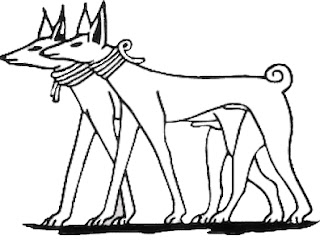The now-extinct Tesem (a type of dog - not a breed) is one of the earliest known domesticated dogs.
Images of the Tesem have been found on ancient Egyptian artifacts and hieroglyphics dating back to 3200 BC. The Tesem, which roughly translates to hunting dog, was a hunter, guard and companion. This greyhound-like dog had a lean body, long legs, prick ears and a curled tail. Two notable dogs were Akbaru, who belonged to King Khufu (2589-2566 BC) and was said to have been buried in the king's tomb with him, and Abuwtiyuw, who was believed to be a royal guard dog during the Sixth Dynasty (2345-2181 BC) belonging to a servant of a King whose name is unknown. Abuwtiyuw received an elaborate burial fit for a king, and his stele reads:
"His Majesty ordered that he be buried ceremonially, that he be given a coffin from the royal treasury, fine linen in great quantity, and incense. His Majesty also gave perfumed ointment and ordered that a tomb be built for him by the gangs of masons. His Majesty did this for him in order that he [the dog] might be honored before the great god, Anubis." (Hobgood-Oster, 41-42).
It is believed that both the Africanis and Basenji are descendants of the Tesem, and the Tesem influenced the development of sighthounds such as the Saluki, Sloughi and Azawakh.













